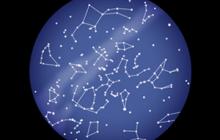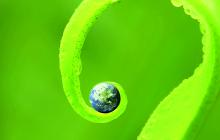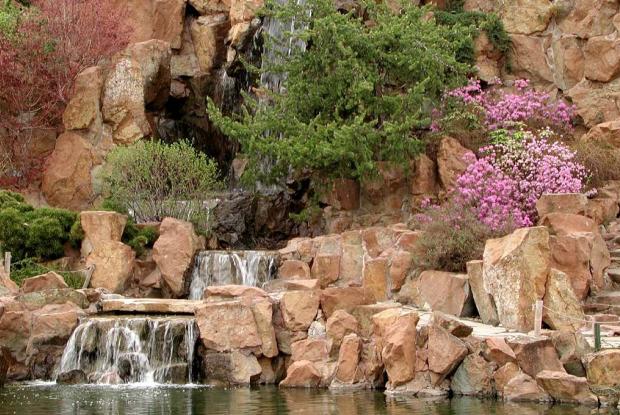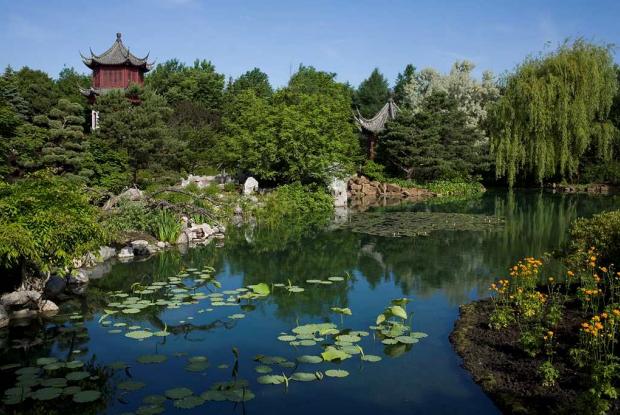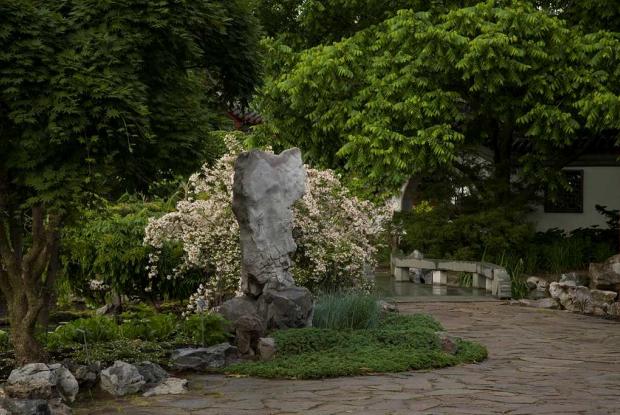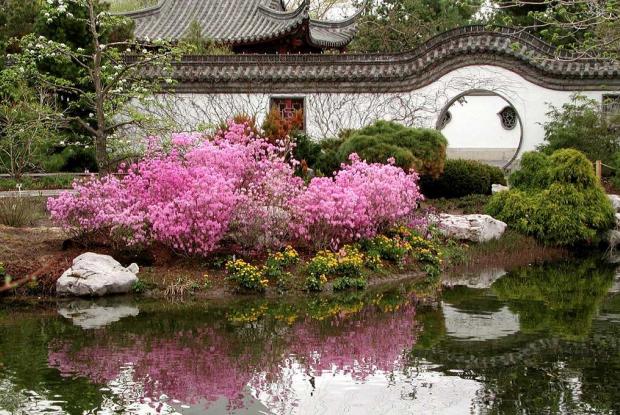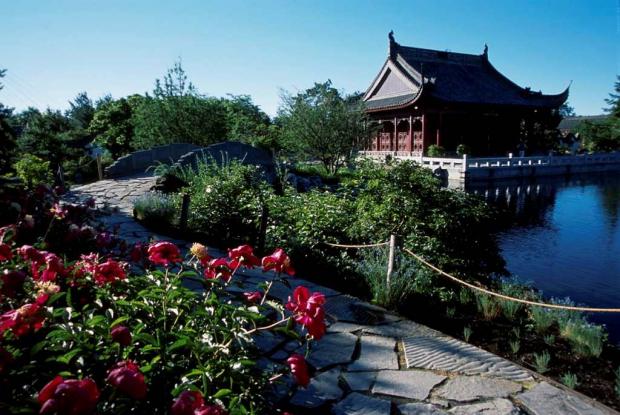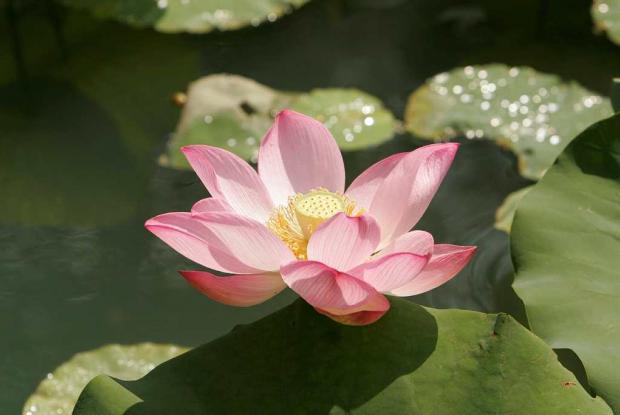Water, stones and plants help to create an image that is both harmonious and full of contrast in the Jardin botanique's Chinese Garden. Here is how these elements fit into the garden and what their meaning represents.
Water
Water occupies an important place in the Dream Lake Garden. Water, which forms the Earth's arteries, symbolizes both life and the feminine principle of the universe (yin). Its flat surface works like a mirror and seems to increase the dimensions of the surroundings. Water is essential to the representation of nature as a whole, and its horizontal line counterbalances the effect of the mountains. Water is one of the dominant, unifying elements of this garden.
The lake is 60 meters long by 40 meters wide. Reflections, along with the bridges spanning the water's branches, serve to make the garden appear even larger.
In some places, rock comes into contact with water; near the falls, large rocks emerge from the water. Rock and water are opposites: the water is yin, the rock yang. They are opposites, but they are linked, since they are two elements of a whole. From contrast and complementarity, harmony is born.
Stones
If water represents the earth's arteries to the Chinese, stone, for them, is the skeleton. Stone is omnipresent in a garden and is perhaps the most distinctive element; it is to the Chinese garden as flower beds and lawns are to Western yards.
The grey rocks in this garden come from Tai Lake (500 metric tonnes imported from China), and the yellow ones from St. Hélène Island (set in the middle of the St. Lawrence Seaway, across from Montréal).
Rock was used as an isolated sculpture, chosen for its resemblance to whatever element or image one wanted to evoke. Heaped together, stones could form more complex mineral landscapes and recreate real mountains.
Plants
The Chinese Garden has more than 200 varieties of perennials, aquatic plants, climbers, bamboos, annuals, shrubs and a hundred varieties of trees.
In a Chinese garden, look neither for the lawns of the English garden nor the precise lines of the French garden.
Chinese gardens favor plants and trees that tradition and history have imbued with symbolism. Designers prefer single flowering perennials over annuals.
The Scotch Pine (Pinus sylvestris) is a very important plant, representing longevity and the struggle for survival. Because it stays green, it is, along with the bamboo plant and the apricot tree, one of the "three friends of winter."
The magnolia tree has traditionally represented wealth. It is also the emblem of Shangai.
Flowers that are rich in meaning
In China, the azalea (Rhododendron spp.), together with the primrose and the gentian, is considered one of the "three famous flowers." The azalea bush and the cuckoo bird are said to be brother and sister since, in April, the bird sings its mournful song on the flowering branches of this plant.
The tree peony (Paeonia suffruticosa) is from China. It embodies aristocracy, wealth and social status. It is the queen of flowers, paradoxically representing both female beauty and, the yang, the male principle. It may be one of the first flowers ever to be cultivated simply for ornamental purposes. Initially reserved for the emperor, then the richest classes, it eventually became accessible to all and was grown throughout China. The plants generally bloom profusely in June.
A chrysanthemum (Chrysanthemum x grandiflorum), also from China, produced the large-flowered specimen we see today. Once used for medicinal purposes, this plant is now appreciated for its ornamental value and serves as a flavoring in certain types of tea.
Sweet osmanthus (Osmanthus fragrans) evokes autumn, the season when it blooms. It is said to be princely, elegant and eternal. It is also associated with the moon because, according to the legend, that is where a hare prepared an elixir of life in the shadow of the sweet osmanthus leaves. The creamy white flowers give off a subtle yet long-lasting scent similar to jasmine and are used in tea, wine, medecine and perfume.
Bamboo
Botanists consider bamboo a giant grass, or graminae. Extremely supple, it bends in the wind without ever breaking. It is the Confucian symbol of the true gentleman. The hollow bamboo stem grows in sections joined by hard, thick joints; its leaves are narrow, delicate and pointed. There are more than one thousand species of bamboo, ranging in height from less than one metre (3 ft) to more than 30 metres (98 ft).
Bamboo shoots are a part of the Chinese diet. Bamboo is also a favorite food of the panda, the black and white mammal that is China's emblem. Bamboo is also widely used throughout Asia to make an array of objects for daily use. The seven buildings in this garden were constructed using lightweight yet strong bamboo scaffolding.
Some plants from China you will see in the garden
- Bamboo (Phyllostachys spp.)
- Kurile cherry ((Prunus nipponica var. Kurilensis)
- Peking Cotoneaster (Cotoneaster acutifolius)
- Manchurian Golden-bells (Forsythia x mandshurica)
- Maidenhair Tree (Ginkgo biloba)
- Fragant Plantain Lily (Hosta plantaginea)
- Primrose Jasmine (Jasminum mesnyi)
- Sacred Lotus (Nelumbo nucifera)
- Chinese Matrimony Vine (Lycium chinense)
- Dawn Redwood (Metasequoia glyptostroboides)
- Manchurian Walnut (Juglans mandshurica)
- Fragrant Olive (Osmanthus fragrans)
- Tree Peony (Paeonia suffruticosa)
- Buddhist Pine (Podocarpus macrophyllus)
- Pear Tree (Prunus ussuriensis)
- Thunberg Spirea (Spiraea chamaedryfolia var. pilosa)
- Thuja (Thuja koraiensis)


